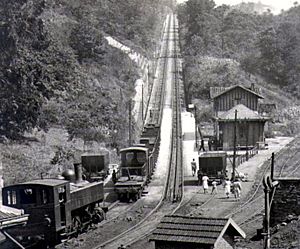Ferrocarril de Langreo facts for kids
Ferrocarril de Langreo, also known as FC de Langreo or FCL, was an important Spanish railway company. It operated a train line in the Asturias region, located in northern Spain. This railway was one of the very first train lines built in the country. It started running in the 1850s, making it the third railway ever constructed in Spain.
Contents
History of the Langreo Railway
The Langreo Railway was a private company. Its main job was to transport important materials. It moved coal and iron ore from mines in Laviana and Langreo. It also carried goods from the La Felguera factory. All these materials were taken to the city of Gijon. The railway line was about 50 kilometers (31 miles) long.
Unique Train Tracks
The Langreo Railway had a special track width. Most Spanish railways used a different size. This railway used a track width very close to what is called "standard gauge." This was unusual for a non-city railway in Spain. Because of this, the company often bought used trains. Many of these trains came from the United States.
Trains from the United States
Over the years, the Langreo Railway bought several interesting trains:
- In 1959, they bought five steam locomotives. These were powerful 2-8-0 type engines. They came from the Alaska Railroad and kept their original numbers.
- In 1964, they acquired special passenger cars. These were Talgo sets, originally built for the New York, New Haven and Hartford Railroad. They were part of a famous train called the John Quincy Adams.
- Also in 1964, they purchased four diesel-electric locomotives. These were ALCO RS-3 units. They came from the Terminal Railroad Association of St. Louis.
- A fifth ALCO RS-3 unit, numbered 1604, was bought in 1971. This one came from the Burlington Northern Railroad. It was extra stock from a big railway merger in 1970.
Joining FEVE
In 1973, the Ferrocarril de Langreo company changed. It became part of a larger railway company called FEVE. FEVE stands for Ferrocarriles Españoles de Vía Estrecha. This means "Spanish Narrow-Gauge Railways."
After joining FEVE, the Gijon-Laviana line was rebuilt. In 1983, its tracks were changed. They were converted to a 1000mm (3 ft 3 3⁄8 in) metre gauge. This made the line fit with FEVE's other narrow-gauge railways.
See also
 In Spanish: Ferrocarril de Langreo para niños
In Spanish: Ferrocarril de Langreo para niños
- FEVE
- History of rail transport in Spain
- RENFE
- Transportation in Spain
External links
- Steam locomotives of the FC de Lagreo
- The Railfaneurope.net Picture Gallery



